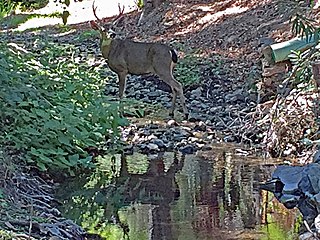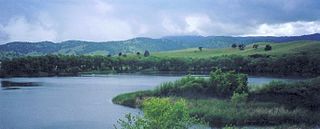
Antioch is the third-largest city in Contra Costa County, California, United States. The city is located in the East Bay region of the San Francisco Bay Area along the Sacramento–San Joaquin River Delta. The city's population was 115,291 at the 2020 census. The city has grown substantially more diverse since the 1970s.

The East Bay Regional Park District (EBRPD) is a special district operating in Alameda County and Contra Costa County, California, within the East Bay area of the San Francisco Bay Area. It maintains and operates a system of regional parks which is the largest urban regional park district in the United States. The administrative office is located in Oakland.

The Xerces Society for Invertebrate Conservation is a non-profit environmental organization that focuses on the conservation of invertebrates considered to be essential to biological diversity and ecosystem health. It is named in honor of an extinct California butterfly, the Xerces blue.

Shoreline at Mountain View is a park in Mountain View, California, United States. The city park was dedicated in 1983, some fifteen years after the City undertook the daunting task of planning a regional park that would provide citizens with environmentally savvy recreation opportunities, from a site that was originally a landfill.

Stevens Creek is a 20.9-mile-long (33.6 km) stream in Santa Clara County, California. The creek originates in the Santa Cruz Mountains on the western flank of Black Mountain in the Monte Bello Open Space Preserve near the terminus of Page Mill Road at Skyline Boulevard. It flows southeasterly through the Stevens Creek County Park before turning northeast into Stevens Creek Reservoir. It then continues north for 12.5 miles (20.1 km) through Cupertino, Los Altos, Sunnyvale and Mountain View before emptying into the San Francisco Bay at the Whisman Slough, near Google's main campus.

The Golden Gate Biosphere Network is a voluntary coalition of federal, state, and local government agencies, nonprofit organizations, universities, and private partners within the Golden Gate Biosphere region. The Network works towards protecting the biosphere region's biodiversity and conserving its natural resources to maintain the quality of life for people within the region. The Network has been part of the UNESCO Man and Biosphere Programme since 1988 and is part of the US Biosphere Network and EuroMAB. It is recognized by UNESCO due to the significant biodiversity of the region, as well as the Network's efforts to demonstrate and promote a balanced relationship between humans and the biosphere.

The Center for Biological Diversity is a nonprofit membership organization known for its work protecting endangered species through legal action, scientific petitions, creative media and grassroots activism. It was founded in 1989 by Kieran Suckling, Peter Galvin, Todd Schulke and Robin Silver. The center is based in Tucson, Arizona, with its headquarters in the historic Owls club building, and has offices and staff in New Mexico, Nevada, California, Oregon, Illinois, Minnesota, Alaska, Vermont, Florida and Washington, D.C.

Ocean Conservancy is a nonprofit environmental advocacy group based in Washington, D.C., United States. The organization seeks to promote healthy and diverse ocean ecosystems, prevent marine pollution, climate change and advocates against practices that threaten oceanic and human life.

The Los Vaqueros Reservoir and watershed is located in the northern Diablo Range, within northeastern Contra Costa County, northern California. It was completed by the Contra Costa Water District (CCWD) in 1998 to improve the quality of drinking water for its 550,000 customers in Central and Eastern Contra Costa County. The reservoir is accessible via Vasco Road, a road which connects Brentwood and Livermore.
Turtle Island Restoration Network (TIRN) is a United States 501(c)(3) non-profit organization founded in 1999 whose mission is "To take swift and decisive action to protect and restore marine species and their habitats and to inspire people in communities all over the world to join us as active and vocal marine species advocates."
The Sea Turtle Restoration Project (STRP), founded in 1989, is a project of Turtle Island Restoration Network (TIRN), a United States 501(c)(3) nonprofit environmental organization with a goal of protecting endangered sea turtles from human-caused threats at nesting beaches and in the ocean.
SPAWN, the Salmon Protection and Watershed Network, is a project of the Turtle Island Restoration Network (TIRN), a United States 501(c)(3) nonprofit environmental organization.
Chelsea Wetlands is a riparian marsh on lower Pinole Creek and a tidal wetland at its mouth on San Pablo Bay, in Contra Costa County, northern California. It is located within the city of Hercules, in the East Bay region of the San Francisco Bay Area.

Permanente Creek is a 13.3-mile-long (21.4 km) stream originating on Black Mountain in Santa Clara County, California, United States. Named by early Spanish explorers as Arroyo Permanente or Río Permanente because of its perennial flow, the creek descends the east flank of Black Mountain then courses north through Los Altos and Mountain View, discharging into southwest San Francisco Bay historically at the Mountain View Slough but now virtually entirely diverted via the Permanente Creek Diversion Channel to Stevens Creek and Whisman Slough in San Francisco Bay.

Marsh Creek is a stream in east Contra Costa County, California in Northern California which rises on the eastern side of Mount Diablo and flows 30 miles (48 km) to the Sacramento–San Joaquin River Delta at Oakley, California, near Big Break Regional Shoreline. The creek flows through Marsh Creek State Park (California), where water is impounded to form Marsh Creek Reservoir, then through the city of Brentwood, California.
Ecology Project International is a non-profit organization based in Missoula, Montana, dedicated to developing place-based, ecological education partnerships between local experts and youth to address conservation issues. Ecology Project International (EPI) works with students and educators at seven program sites around the world: Belize, Costa Rica, mainland Ecuador, Galápagos Islands, Hawaii, Mexico, and Yellowstone.
Restore America's Estuaries (RAE) is a national 501(c)(3) non-profit conservation organization dedicated to preserving the nation's network of estuaries through coastal protection and restoration projects which promote the richness and diversity of coastal life. Based in Arlington, VA with staff in Seattle, Colorado, and Florida, Restore America's Estuaries is an alliance of eleven community-based coastal conservation organizations that includes the American Littoral Society (ALS), Chesapeake Bay Foundation (CBF), Coalition to Restore Coastal Louisiana (CRCL), Conservation Law Foundation (CLF), Galveston Bay Foundation (GBF), North Carolina Coastal Federation (NCCF), Save The Bay – San Francisco (STB-SF), EarthCorps, Save The Bay – Narragansett Bay (STB-NB), Save the Sound (STS) - a program of Connecticut Fund for the Environment, and Tampa Bay Watch (TBW).
Golden Gate Bird Alliance is an American 501(c)(3) non-profit environmental organization engaged in bird conservation and environmental awareness. Located in the David Brower Center in Berkeley, California, Golden Gate Bird Alliance was formed in 1917 and incorporated into the National Audubon Society in 1948. With 3586 members and supporters, Golden Gate Bird Alliance spans Northern California, with a particular focus on San Francisco County, West Alameda County, and West Contra Costa County.












